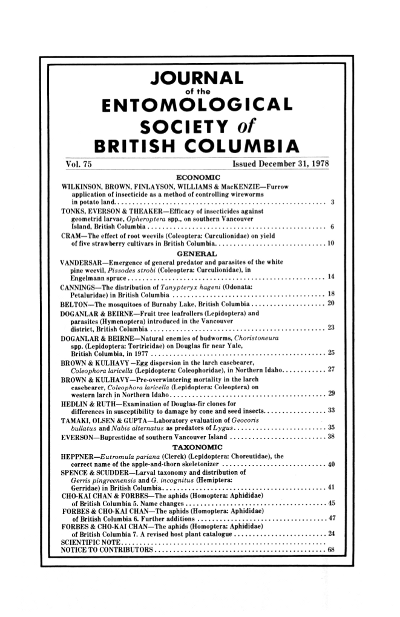Examination of Douglas-fir clones for differences in susceptibility to damage by cone and seed insects
Keywords:
Douglas-fir, cone insects, <i>Barbara colfaxiana</i>, <i>Contarinia oregonensis</i>, <i> Contarinia washingtonensis<i/>, <i>Megastigmus spermotrophus</i>Abstract
In 1974 and 1976, Douglas-fir cones from 51 clones and 150 clones, respectively, were collected and determinations were made of the percentage of seed damaged by the cone insects <i>Barbara colfaxiana</i>, <i>Contarinia oregonensis</i>, <i>C. washingtonensis<i/> and <i>Megastigmus spermotrophus</i>. Although statistically significant differences in percentage of damaged seeds were detected among clones, these differences were not great enough to be of practical importance.References
DeBarr, G.L., E.P. Merkel, C.H. O'Gwynn, and M.H. Zoerb, Jr. 1972. Differences in insect infestation in slash pine seed orchards due to phorate treatment and clonal variation. For. Sci. 18:56-64.
Merkel, E.P., A.E. Squillace, and G.W. Bengston. 1965. Evidence of inherent resistance to Dioryctria infestation in slash pine. Proc. 8th South. Conf. For. Tree Improvement. pp 96-99, Savannah, Ga.
Snyder, E.G. 1972. Glossary for forest tree improvement workers. South. For. Expt. Sta. Forest Service, USDA, New Orleans, La.
Downloads
Published
Issue
Section
License
Authors who publish with the Journal of the Entomological Society of British Columbia agree to the following terms:
-Authors retain copyright and grant the journal right of first publication with the work simultaneously licensed under a Creative Commons Attribution License that allows others to share the work with an acknowledgement of the work's authorship and initial publication in this journal.
-Authors are able to enter into separate, additional contractual arrangements for the non-exclusive distribution of the journal's published version of the work (e.g., post it to an institutional repository or publish it in a book), with an acknowledgement of its initial publication in this journal.
-Authors are permitted and encouraged to post their work online (e.g., in institutional repositories or on their website) prior to and during the submission process, as it can lead to productive exchanges, as well as earlier and greater citation of published work (See The Effect of Open Access).


